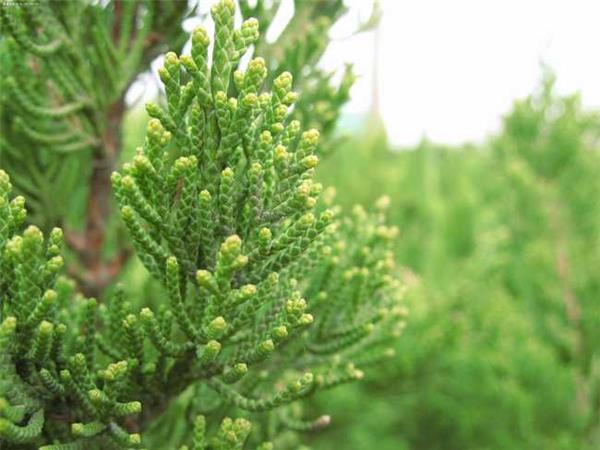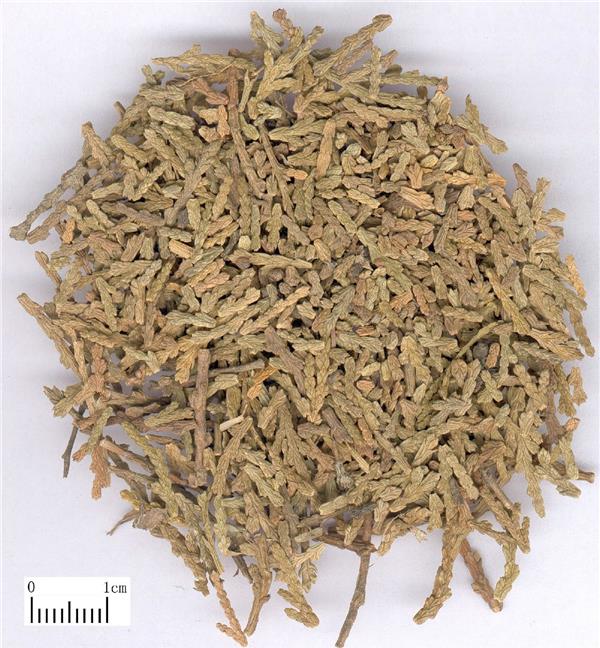[what are Platycladus orientalis leaves] the efficacy and function of Platycladus orientalis leaves
The color of the leaves of Platycladus orientalis is mainly reddish brown, which is a kind of medicine that can be easily identified. Let's learn more about it.

What are the leaves of Platycladus orientalis?
Platycladus orientalis: the tender branches and leaves of Platycladus orientalis. The leaves of Platycladus orientalis are mostly branched, small and of different length, and are scaly. The color is reddish brown. On the surface, the leaves are opposite to each other, and the cross section is yellow and white. The texture is crisp and easy to break. One of the blood-cooling and hemostatic drugs of bitter and astringent traditional Chinese medicine, which has the effects of stopping bleeding, black hair, cough and asthma.
Morphological features: the leaves of Platycladus orientalis are the leaves of the plant Platycladus orientalis. The original species is a tree with a height of more than 20 meters and a breast diameter of 1 meter; the bark is thin, light grayish brown, split longitudinally into pieces; the branches extend upward or obliquely, the crown of the young tree is ovate minaret, and the crown of the old tree is wide and round; the branchlets of scale leaves are thin, straight or oblique upward, flattened and arranged in a plane. The leaves are scaly, 1-3 mm long, the apex is slightly obtuse, the exposed part of the leaves in the center of the branchlet is Obovate rhomboid or rhomboid, there are striped glandular grooves in the middle of the back, the boat-shaped leaves on both sides, the apex is slightly inward curved, there is an obtuse ridge on the back, and there are glandular dots below the tip. Male cones yellow, ovoid, ca. 2 mm; female cones subglobose, ca. 2 mm in diam., bluish green, glaucous. Cones subovoid, 1.5-2 (- 2.5) cm long, nearly fleshy before maturity, turquoise, whitewashed, woody after maturity, dehiscent, reddish brown; middle two pairs of seed scales Obovate or oval, with curved tips below the dorsal tip of the scales, the upper pair of scales narrow and long, nearly columnar, with upward tips at the top, and the lower pair of scales very small, up to 13 mm long, sparsely degraded but insignificant. Seeds ovoid or subelliptic, apical puberulent, grayish brown or purplish brown, 6-8 mm long, slightly ridged, wingless or with very narrow wings. The flowering period is from March to April, and the cones mature in October.

The efficacy of Platycladus orientalis leaves
The main results are as follows: 1. The cause of hair loss in traditional Chinese medicine is mainly around the idea of tonifying kidney and blood, and it is believed that hair loss is caused by blood heat, kidney deficiency and body dysfunction. Platycladus orientalis leaves are good for hemostasis and removing dampness and heat recorded in traditional Chinese medicine, which plays a very obvious role in regulating blood circulation and removing blood heat, which is consistent with the principle of hair loss in traditional Chinese medicine. therefore, shampoo with Platycladus orientalis leaves has been handed down as a folk prescription for hair generation in traditional Chinese medicine.
2. According to the clinical research in recent years, it has been found that Platycladus orientalis leaves also have the effects of relieving cough and expectorant, preventing and treating alopecia, so they are often used in senile chronic tracheitis and treat a variety of alopecia symptoms, and achieved satisfactory results.
3. According to scientific research, the leaves of Platycladus orientalis contain a lot of volatile oil, the main components of the oil are Platycladene and cumin, and the leaves also contain many trace elements such as potassium, sodium, phosphorus, nitrogen, calcium, magnesium, manganese and zinc. Pharmacologically, the decoction of Platycladus orientalis leaves can significantly shorten the bleeding time and clotting time, and its effective hemostatic components are quercetin and tannin.

Control of leaf blight of Platycladus orientalis
Platycladus orientalis leaf blight: the bacteria spent the winter on the diseased leaves and began to move in April of the following year. In May, the diseased leaves began to infect from the lower part of the crown, and the diseased leaves appeared macula at the initial stage, which gradually expanded, making the whole cypress leaves yellow and finally yellowish brown. In June, black spots appeared on the diseased leaves, that is, the reproductive organs of the bacteria, and released spores for re-transmission. If the forest is dense, the humidity in the forest is high, and the temperature is suitable, it will spread and infect in large numbers, resulting in a pandemic of the disease, with the most serious disease from June to July. There is often a disease center in the dense forest, which gradually spreads out into a piece, and when it is serious, it looks like a fire, and a large number of diseased leaves fall off, often sprouting clumps of new leaves from the branches of the tree trunk, and people call it "tree beard."
Prevention and control methods:
1. Clean the diseased leaves under the tree in autumn and winter, burn and dye the source. Eliminate the pathogen of winter and reduce the first invasion
2. From May to August, spray Bordeaux solution with Bordeaux liquid once every two weeks, especially pay attention to strictly control the primary infection, find the center of primary infection, block it and prevent it from spreading.
3. The over-dense cypress forest should be thinned properly to make the forest ventilated and transparent and reduce the disease conditions.

In addition to the prevention and control of diseases, we should also pay attention to some daily maintenance measures in the process of planting Platycladus orientalis, such as water and fertilizer, pruning and so on, so as to ensure the healthy growth of Platycladus orientalis. Thus grow bright color, full and juicy leaves of Platycladus orientalis.
- Prev

Planting and maintenance of ginseng fruit trees how to plant ginseng fruit trees
Planting and maintenance of ginseng fruit trees how to plant ginseng fruit trees
- Next

[Camellia oleifera grafting Camellia] how Camellia oleifera grafts camellias
[Camellia oleifera grafting Camellia] how Camellia oleifera grafts camellias
Related
- Wuhan Hospital Iron Tree Blooming Result Was Instantly Frightened by the Gardener Master
- Which variety of camellia is the most fragrant and best? Which one do you like best?
- What is the small blue coat, the breeding methods and matters needing attention of the succulent plant
- Dormancy time and maintenance management of succulent plants during dormancy
- Minas succulent how to raise, Minas succulent plant pictures
- What are the varieties of winter succulent plants
- How to raise succulent plants in twelve rolls? let's take a look at some experience of breeding twelve rolls.
- Attention should be paid to water control for succulent plants during dormant period (winter and summer)
- Watering experience of twelve rolls of succulent plants
- Techniques for fertilizing succulent plants. An article will let you know how to fertilize succulent plants.

